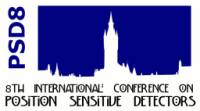Description
PET applications
Alberto del Guerra
04/09/2008, 16:10
PET applications
Keynote talk
In 1985 the introduction of the block detector by Mike Casey and Ronald Nutt, changed the world of nuclear imaging. This invention has made possible high-resolution PET tomographs at a much-reduced cost. Almost all dedicated tomographs built since 1985 have used some forms of the block detector. In the last twenty years most of the additional improvement in PET technique was due to the...
Dr
Jun Kataoka
04/09/2008, 16:50
PET applications
Oral Contribution
Avalanche photodiode (APD) offers an advantage in weak scintillation detection, fast time response, as well as magnetic field insensitivity. We have developed large-area APD arrays with Hamamatsu phonics K.K, specifically designed for high resolution positron emission tomography (PET). Each device has a monolithic 16x16 (or 8x8) pixels structures with an active area of 1.0 (or 4.0) mm^2 for...
Mr
Makoto Koizumi
04/09/2008, 17:10
PET applications
Oral Contribution
We report on the development of the front-end ASIC for high spatial resolution PET detectors with time-of-flight capability based on LYSO scintillator arrays coupled with position-sensitive avalanche photodiode (APD) arrays. The ASIC is designed on the basis of the Open-IP LSI project led by JAXA and realized in TSMC 0.35um CMOS technology. It is composed 8 channels of charge sensitive...
Dr
Mary Chin
04/09/2008, 17:30
PET applications
Oral Contribution
THE GAMMASPHERE is a unique facility for gamma-ray spectroscopy. The spherical array of 110 Compton-suppressed high-purity germanium (HPGe) detectors features a powerful combination of high sensitivity, resolution, granularity and efficiency. Many quantities previously not measurable became possible; breakthroughs continue to emerge across the fields of nuclear physics, particle physics and...
Dr
Mercedes Rodriguez-Villafuerte
04/09/2008, 17:50
PET applications
Oral Contribution
A microPET system for small animal studies is currently being developed at Instituto de Fisica, UNAM. The main goal of this project is to build a cost-effective benchtop system that could be suitable for research purposes. The basic design uses off-the-shelf components and is being assembled using in-house built readout circuits and NIM electronics. In this work we are presenting the initial...
Dr
David Parker
(University of Birmingham)
04/09/2008, 18:10
PET applications
Oral Contribution
The technique of positron emission particle tracking (PEPT), developed at Birmingham in the early 1990s, enables a radioactively-labelled tracer particle to be accurately tracked as it moves between the detectors of a positron camera. In 1999 the original Birmingham positron camera, which consisted of a pair of MWPCs, was replaced by a system comprising two NaI(Tl) gamma camera heads...

